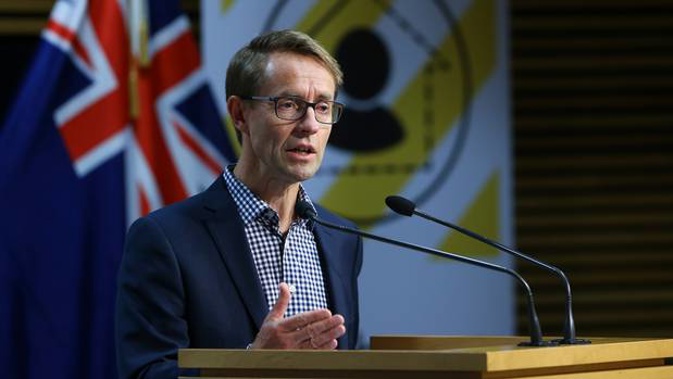
Director general of health Ashley Bloomfield wanted anyone with Covid-19 during alert level 2 to be placed into managed isolation until they had recovered.
The advice is contained in a Ministry of Health report from May 1, which was used to advise Cabinet on moving to different alert levels.
The Government has today released a series of documents relating to its handling of the Covid-19 crisis.
"Because of the increased range of movement and contact possible under level 2, and the importance of reducing the risk of transmission, a stronger approach to isolating confirmed cases and their contacts will be required," Bloomfield said in the report.
"In the event of a case being confirmed, I intend to require that person to enter managed isolation until such time as they have recovered (shown no symptoms for 48 hours at least 10 days after onset).
"Similarly, their contacts will be required to enter self-isolation and will be actively monitored including up to twice daily visits to monitor their location and any symptoms."
He added that there was no good reason at that stage for different regions to move to level 2 at different times.
"It is possible there may need to be increased controls in particular areas in the future.
"This might happen if, say, there was an outbreak in a location with no spread elsewhere."
"However, it is most likely that such outbreaks will be localised (perhaps around an institution) and will not map to a wider regional geography or require an explicit change in the alert status of a whole region."
Public health measures were the first response in a localised outbreak, he said, including surveillance testing to find undetected cases and rapid contact tracing and isolation.
"This should take place locally at the appropriate boundary around an outbreak based on the specific circumstances, not be defined by a pre-determined regional map."
In an April 15 paper, the Ministry of Health said it was against regional lockdowns because it could undermine public compliance.
In his May 1 report, Bloomfield said that a regional lockdown could be avoided because there were sufficient powers to, for example, close buildings, quarantine people and restrict travel.
"This sort of activity could take place at a regional level, if the conditions require."
He said the key factor to consider moving to level 2 was having at least 28 days without any significant community transmission.
"The question of 'significance' here does not necessarily mean zero cases for 28 days, but would take into account the circumstances of any new cases of community transmission and the risk associated."
The last significant case was on April 2, even though there had been dozens of community transmission cases right until April 30.
Alert level 3 move beset by PPE shortages, testing turnaround speeds
The day Prime Minister Jacinda Ardern announced the country will move to level 3, problems continued to plague the quality of Covid data and the turnaround speed of testing, while stocks of certain PPE were too low to meet expected demand.
The information is contained in a weekly Covid report that was presented to Cabinet on April 22, two days after Ardern had announced that level 3 would commence from April 28.
The report - part of hundreds of official documents dumped by the Government this morning - said that lockdown had a significant impact on people's well-being, with a rise in feelings of loneliness, anxiety and depression.
It said there was sufficient testing capacity but "the average speed of the process needs to improve".
And while a drop in daily cases and few people in hospital pointed to a lack of community transmission, issues remained about the quality of data and the end-to-end trace and isolate system.
"There are some problems with data quality regarding source of transmission. Ministry of Health officials are working with ESR [Institute of Environmental Science and Research] and public health units on this," the report said.
The ministry was in the process of setting up key performance metrics measuring the time taken from a person's first symptoms to having isolated 80 per cent of their close contacts.
"This is not yet calculated on a regular basis and will be critically important when making future decisions regarding alert levels," the report said.
The first of these metrics was not publicly released until the first week of May, more than a week after the move to level 3 and just before the move to level 2.
Only 10 active cases could be contact-traced in mid-March, when there were already 125 cases in New Zealand.
The system was rapidly improved, and director general of health Ashley Bloomfield gave repeated assurances that capacity was good enough before the move to level 3.
The weekly report also included a stocktake of PPE supplies for April 20, the day of Ardern's D-Day announcement.
The number of masks, gowns and face shields was good, but there were not enough gloves or disposable aprons - based on anticipated demand in the coming fortnight.
Current and incoming supplies of glasses were also considered to "barely cover" expected demand.
This contrasts with Ardern's advice to Cabinet that there was enough PPE on April 17, which was the day Cabinet made its decision to move to level 3.
PPE supply and distribution was an issue on which Ardern and Bloomfield gave repeated assurances, despite frequent complaints from those of the healthcare frontlines.
A recent report on PPE from the Auditor-General found that the ministry had no idea how much personal protective equipment (PPE) it had, how much it needed, what had expired and how it should be distributed.
It also found that Bloomfield's mixed messages for health workers to "be safe, but feel safe" coupled with changing guidelines had led to a rush on demand.
Director general of health Dr Ashley Bloomfield has given repeated assurances about PPE stocks. Photo / Mark Mitchell
Heavy impact on wellbeing
The weekly report's assessment of those in hardship was also grim, including a doubling of food bank demand.
"Credit application enquiries returning 'hardship flags' almost tripled in April and are expected to rise."
It noted a slight increase in the first week of lockdown in police call-outs for family harm, but questioned whether that was in fact the reality.
"It is unclear if we are getting an accurate picture of harm under lockdown, especially as other sources indicate an increase in help-seeking.
"There is an upwards trend in contacts to Youthline. Suicide and depression continue to be the main reason, but reports of sexual and emotional abuse are relatively high. Help-seeking by men who have previously perpetrated family harm has also risen."
A Te Hiringa Hauora / Health Promotion Agency survey during lockdown reported that 20 per cent of people were drinking more than normal, but a higher proportion of Māori, Pasifika and young people were drinking less.
"Nearly a fifth of respondents (17 per cent) report moderate to severe distress since lockdown. Younger age groups are worst affected.
"People feeling isolated or lonely has increased, especially older people."
It noted anxiety about the high number of essential workers who are Pacific, "and the risks posed to their families".
However, the report said that informal polls showed a majority of New Zealanders were willing to stay at level 4 for longer.
The report repeated previous advice that the Government was essentially flying blind when it came to whether people were properly self-isolating, or whether essential workers were being kept safe in their workplaces.
"As of 9 April, MPI [Ministry for Primary Industries] had completed 2730 on-site verification visits and 2401 remote verifications, resulting in nine warning notices. We do not have data on whether other essential workplaces have robust plans and processes in place.
"Suspected and confirmed Covid-19 cases, as well as close contacts of confirmed cases, are meant to self isolate. We currently have little understanding of compliance with that self-isolation."
It also said that most people - 52 per cent - breaking lockdown rules were known to police as they who had been prosecuted for other offences in the previous two years.
Take your Radio, Podcasts and Music with you








